
7 superb flowerbeds for autumn
Be inspired by these arrangements to create a magnificent late-season garden
Summary
A beautiful autumn garden is within reach of every gardener. Simply follow certain rules and a few simple principles, starting with choice of plants. Here I suggest we examine 7 sumptuous autumn borders, photographed in late October and each evoking a sometimes very different atmosphere. They are sources of inspiration you can recreate or adapt to design your dream autumn garden!
Discover also all our advice for creating a beautiful autumn garden.
Enchanted, multicoloured forest!
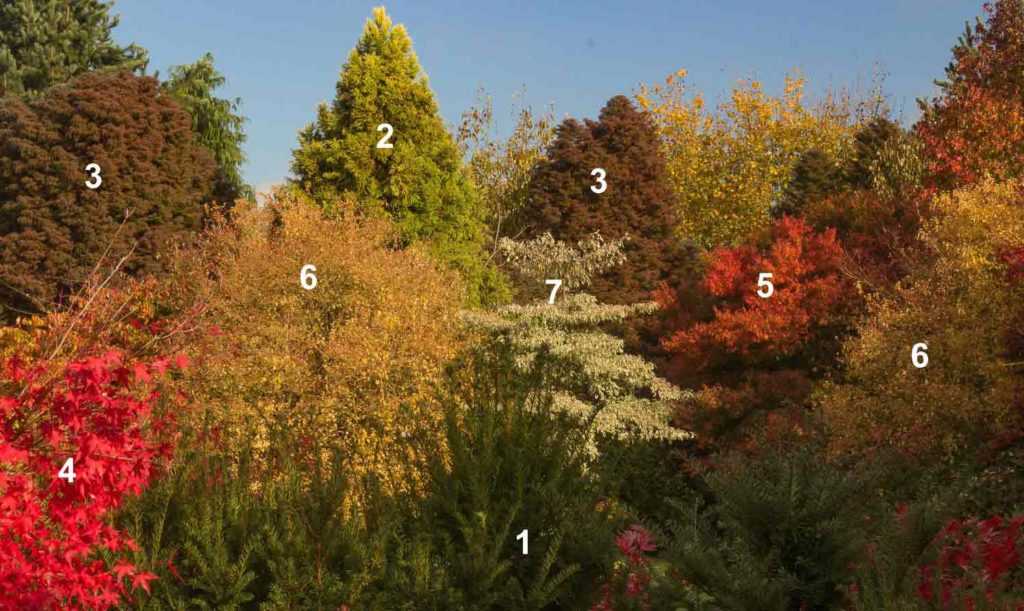
Stunning display of foliage (Jardin du Mesnil) – Copyright: JC Aumont
Here is a superb example of a layout devoted to autumnal colours! Located at the Jardin du Mesnil, this composition has the effect of a true enchanted forest, where shades blend brilliantly. A large emphasis has been placed on evergreen shrubs, thanks to the use of numerous conifers, whose variety of shapes, sizes and colours can be admired! While the yew (1) is quite dark green, the large Cryptomeria japonica ‘Sekkan Sugi’ (2), with its pyramidal habit and which seems to dominate the scene, shows a very fresh light green. This is accompanied by two of its cousins, Cryptomeria japonica ‘Elegans’ (3), whose foliage takes on a rusty hue, preventing any monotony. This base, which has the advantage of remaining present throughout winter, also helps create a frame for the brighter colours of other plants. Two Japanese maples throw their colours into the mix: Acer palmatum ‘Orange Dream’ (4), and another maple (5), raised from sowing this time, both with particularly vivid hues. Each of these maples is paired with a coloured wood dogwood, Cornus sanguinea ‘Magic Flame’ (6). Little constrained by pruning, they have reached fine dimensions and easily exceed 2 metres. Their orange wood will be breathtaking in winter, once they have shed their leaves and stand out against the conifer foliage. The presence of a Cornus controversa ‘Variegata’ (7), with its light variegated foliage, brings a delicate touch and both links the colours together and tempers this profusion of colour.
You may also read
The most beautiful trees and bushes with autumn colouringZen-inspired gravel garden
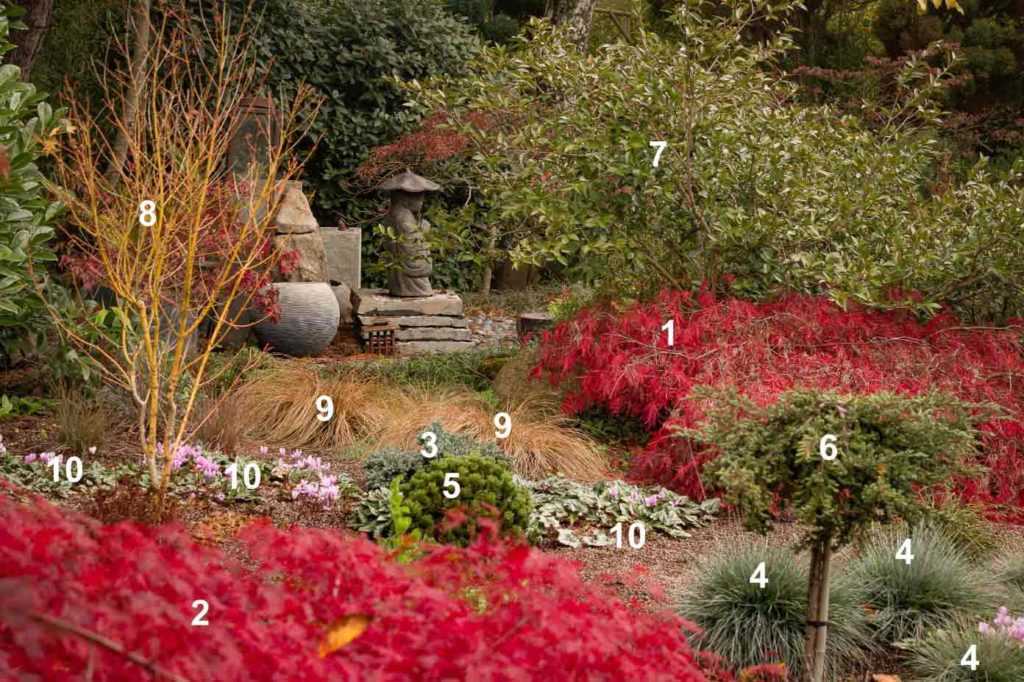
A fine example of a zen garden in autumn (Jardins de la Mansonière) – Copyright : JC Aumont
At Jardins de la Mansonière gardeners created a very calming, zen-inspired space. With statuette, round basin and gravel underfoot, mineral presence is strongly asserted. It works particularly well with plants, whose diversity and ornamental qualities are many. The Japanese maples (1 and 2 – Acer ‘Emerald Lace’) display their decorative, warmly coloured leaves in late season. They are well spaced to create visual echoes, and frame lower planting where several conifers provide a reassuring presence, even in winter. The silvery-blue leaves of a dwarf juniper (Juniperus suqamata ‘Blue Star’ – 3) are echoed by clumps of grasses equally bluish (Festuca glauca ‘Intense Blue’ – 4). A dwarf pine (Pinus mugo – 5), with compact habit, in a regular, bright green ball, and another juniper (Juniperus communis – 6) on a stem, complete the palette of evergreen leaves, as does the autumn camellia (7), whose flowering will extend over several weeks. The Japanese maple ‘Bi Hoo’ (8) has already lost its leaves, but has the advantage of retaining branches of intense yellow, which throw colour into gloomy months (similarly, I can only recommend Acer ‘Sango Kaku’, with its stunning coral-red wood). Its tones are echoed, with more restraint but much grace and lightness, by the languid clumps of Carex ‘Bronze Form’ (9), whose fine bronze leaves are evergreen. To complete the picture, a few Cyclamens of Naples (10) form low tapetum, with decorative leaves and pretty pink flowers.
An elegant, opulent grass border
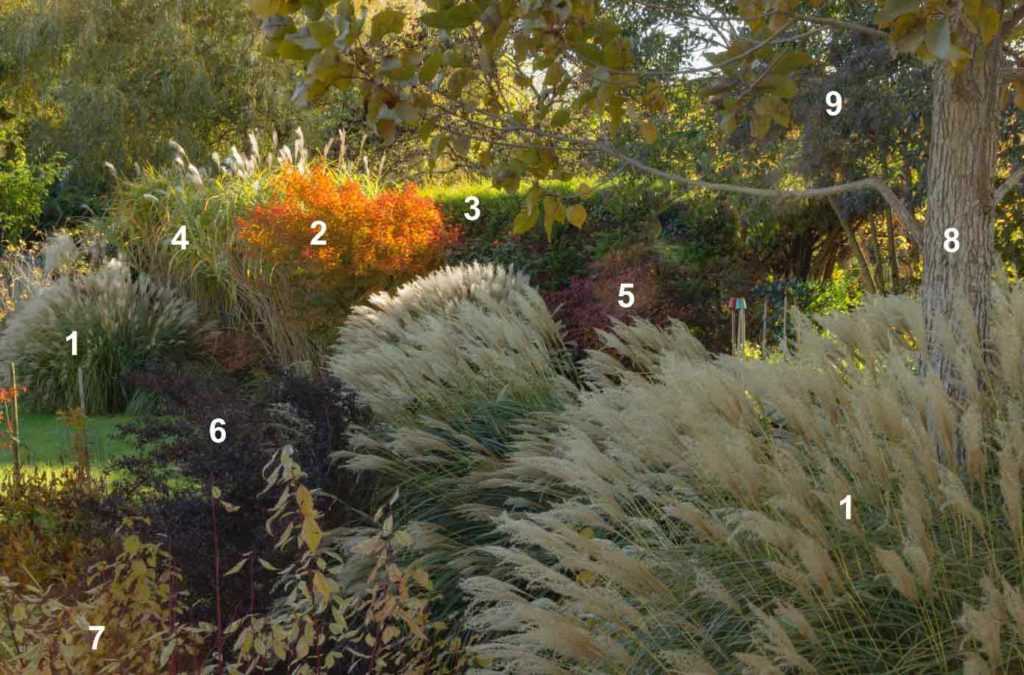
Lush ornamental grass border (Jardin d’Entêoulet) – Copyright: JC Aumont
At Jardin d’Entêoulet, ornamental grasses are the queens of autumn. They structure the borders of this limestone soil for many months, and reveal their full beauty in autumn, when their light, airy spikes dance in the wind. In this example, it is hard not to succumb to the charm of the countless silvery plumes of the large clumps of Miscanthus ‘Yaku-Jima’ (1), with a fountain habit. They give rhythm to the various borders and accompany the coloured foliage of the bushes. The orangey tones of a Japanese maple grown from seed (2) are enhanced by the low afternoon light. It sits against a hedge of Leyland cypress (3), a fast-growing conifer often used to form formal, evergreen hedges. Almost taller than the maple, a large specimen of Miscanthus giganteus (4) stands at the back of the border and displays its long canes. A Viburnum dentatum (5), after producing a generous white flowering in late spring, followed by pretty blue berries, now colours its deciduous leaves a deep red. In deeper, more purple shades, a Physocarpus ‘Little Devil’ (6) strongly contrasts with the Miscanthus spikes, and closes the triangle formed by the three bushes with autumnal colouring. A variegated white dogwood (7), with foliage marginate in white, also takes on warm hues before shedding. Providing a striking vertical element, the pale beige bark, marked by darker striate streaks of a purple poplar (8), whose almost black deciduous foliage lightens in autumn. Behind it, the silhouette of a Japanese privet (9) can be made out which, left unpruned, has become a proper small tree. Its evergreen foliage is scattered with a multitude of small black berries, which follow a generous white, scented summer flowering.
You may also read
Create a beautiful autumn gardenNaturalistic meadow, beautiful and poetic
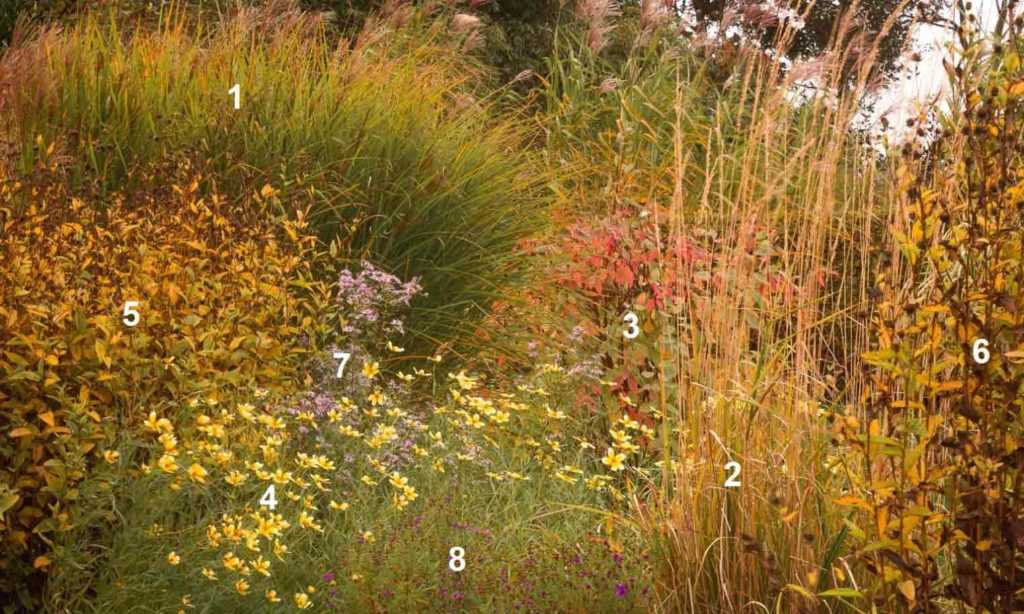
A meadow with a natural spirit (Jardin du Mesnil-Gaillard) – Copyright : JC Aumont
Naturalistic meadows are booming. Inspired by wild, spontaneous meadows, they combine apparent simplicity, structure and colour. In this kind of planting, grasses play a very important role, as they provide strong structure and texture. In this example, photographed at the Jardin du Mesnil-Gaillard, two very fine specimens were chosen. First, a Miscanthus sinensis ‘Rotsilber’ (1), whose foliage often turns a coppery red with the first cold, before decorating the winter garden with straw-coloured tones. Hardy, it produces purplish spikes that turn silvery as they ripen. Calamagrostis acutiflora ‘Karl Foerster’ (2) displays a much more upright, elongated habit. Very popular, this grass has strong structuring power yet still allows the eye to pass through, even when its fine pinkish-white spikes rise above the foliage. It also takes on lovely late-season tones and remains decorative for a long time. The only bush here is a Cornus alba ‘Sibirica’ (3), whose orangey autumn tones and bright red wood revealed throughout winter have made it renowned. The other residents are all flowers with a light, natural appearance. Planted in drifts, or the result of spontaneous sowing, they add welcome touches of colour without ever overwhelming the scene. Thus, a tall Bidens ‘Hannay’s Lemon Drop’ (4), with yellow and white flowers, anchors the warm late-season colours. Helianthus ‘Lemon Queen’ (5) has finished flowering, thus perfectly fulfilling its role as a transition between summer flowering and mid-autumn displays, while its ochre foliage and faded flower buds remain decorative. The same applies to the Helenium (6). Among all these warm tones, the presence of two Asters (7 and 8), one purple, the other more bluish, is a fine example of using complementary colours. Placed apart from one another, they punctuate this composition to create a beguiling symphony of soft colours.
Mix of late-flowering plants and flamboyant foliage
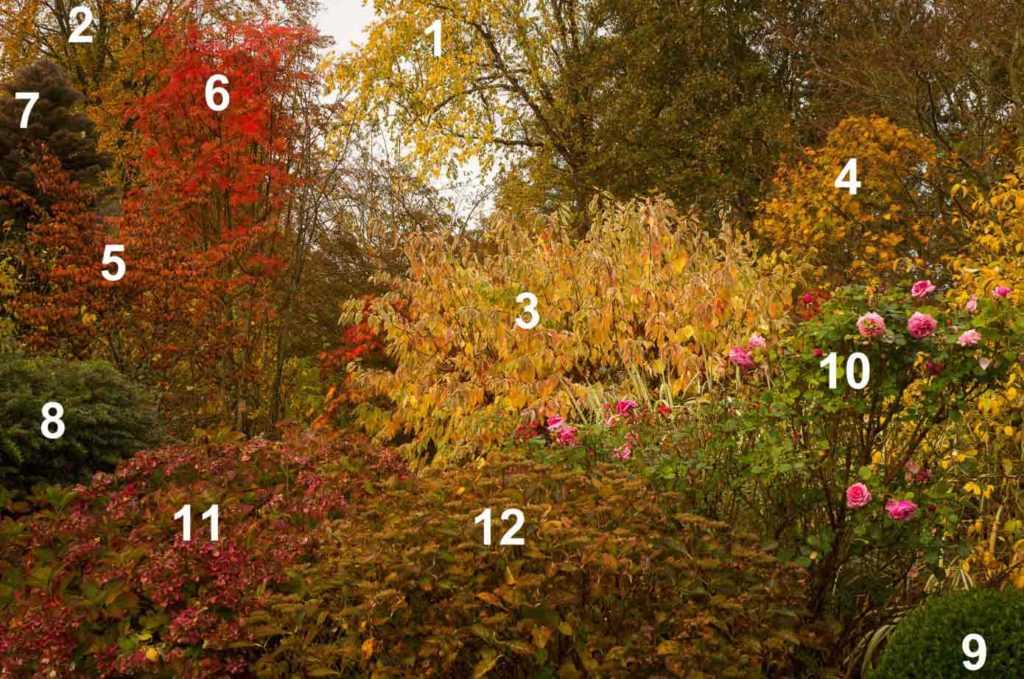
Mixture of foliage and flowers in late season (Jardin du Mesnil) – Copyright: JC Aumont
Jardin du Mesnil again offers a stunning autumn composition. Warm colours dominate, as abundant foliage is present. The silhouette of a large birch (Betula nigra – 1) sets off its golden foliage against the sky. Very hardy and fairly fast-growing, it has ornamental bark and a striking autumn foliage. A Common beech (2) has also changed colour, but unlike its neighbour, deciduous, it retains its dried leaves on its branches throughout winter, before renewing them in spring. In the background, yellow is echoed in slightly different tones by a Cornus alba ‘Elegantissima’ (3) with pretty variegated foliage and by a Japanese maple (4). Another dominant autumn colour, orange appears here in the foliage of a Cornus kousa (5), whose white flowering in late spring and fruiting, resembling strawberries, are two further assets. Easy to grow in soil that is not too calcareous, it is a small tree with slow growth, but particularly decorative from spring to autumn. Behind it stands a Sorbus commixta ‘Olympic Flame’ (6). Rarely cultivated in France, you can choose one of its cousins, Sorbus aucuparia ‘Autumn Spire’, which also takes on beautiful late-season colours. Green, essential to tie together all these bright hues, is provided by a large Cryptomeria ‘Elegans’ (7), though its tones are slightly purplish, and by a Berberis darwinii (8), an evergreen bush and thorny, with bright orange spring flowering. Foliage of a boxwood (9) tempers the scene, as does that of a perpetual-flowering rose (10), although its bright pink flowering provides a cool colour that energises the scene. This shade is echoed, in old-rose tones, by the spent inflorescences of a Hydrangea (11). If its neighbour (12) is paler, both provide a strong presence thanks to their generous shapes, in opulent, cushion-like mounds.
Autumnal grove, like a sunset!
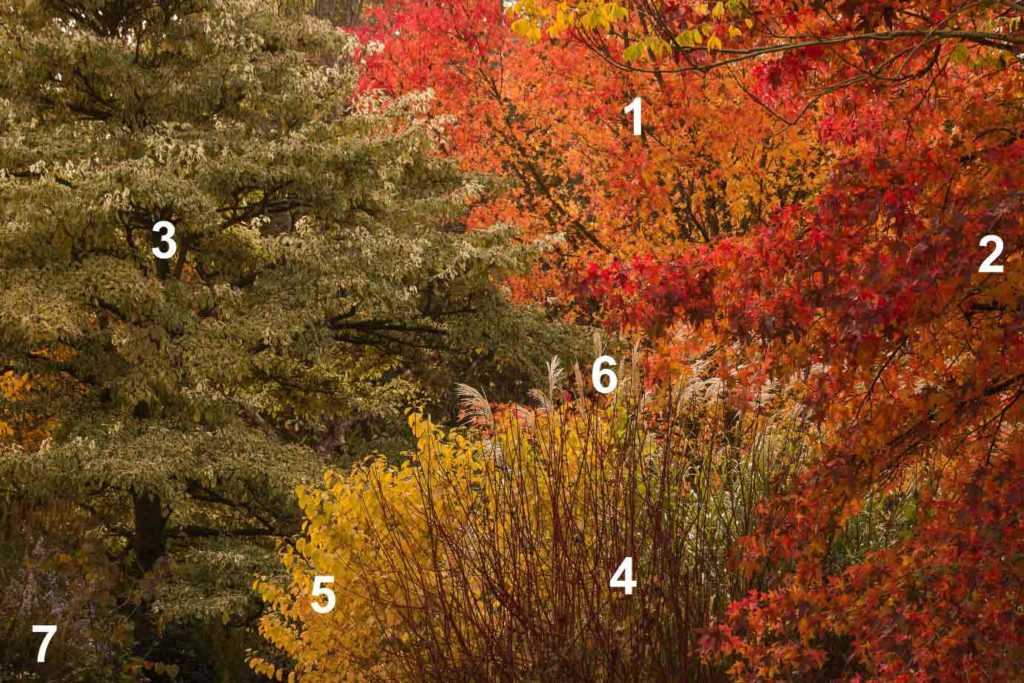
Grove in warm tones (Jardin du Moulin-Ventin) – Copyright: JC Aumont
This autumn scene at Jardin du Moulin-Ventin is a little gem. Yet it is made up of few plants, which combine wonderfully to form this colourful tapestry. Three large trees provide backdrop. First, the unmissable Liquidambars, whose dissected foliage, reminiscent of a maple, are declinated into many shades, from yellow through orange to claret or almost black purple. Varieties shown in image (1- ‘Anja’, and 2- ‘Stella’) can be replaced by other cultivars, the colouring of this tree being reliable every year. In a small garden, choose variety ‘Gumball’, which does not exceed 3 m, or opt, if soil suits them, for Japanese maples, also very rich in late-season colours. The third large subject is a variegated Pagoda dogwood (Cornus controversa ‘Variegata’ – 3). It is a tree with incomparable graphic quality, thanks to its very tabular habit and leaves largely variegated with cream. At 7 m high, spreading 6 m, it therefore needs some space to express itself. In a modestly sized garden, replace it for example with Cornus alternifolia ‘Argentea’, with equally variegated foliage but much more compact (3 m x 2.5 m). Still among dogwoods, two specimens known for the colour of their branches appear. Cornus alba ‘Sibirica’ (4) has already lost its leaves, which highlights its wood of bright red, beautifully set against golden foliage of a Cornus sanguinea ‘Midwinter Fire’ (5). The latter will reveal fluorescent orange branches once leaves have fallen. Both varieties fit into all gardens, as they can be pruned right back each year, thus not exceeding about 1 m to 1.5 m. A Miscanthus ‘Gracillimus’ (6), with very fine, fresh green foliage and silvery spikes, brings a welcome touch of lightness. Another interesting detail is presence of an Aster cordifolius ‘Blütenregen’ (7). Pale mauve of this autumn aster is both complementary colour to dogwood opposite it and a way to introduce a cooler tone, making overall composition even more appealing.
Cheerful composition for a small flowerbed
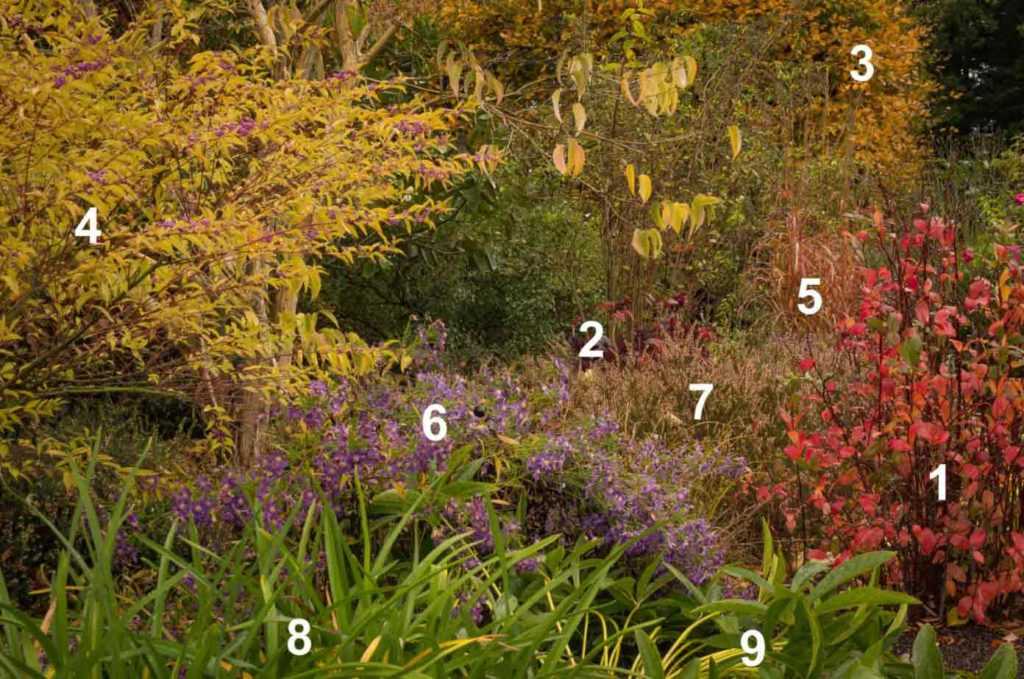
A small colourful flowerbed (Jardin de la Mansonière) – Copyright : JC Aumont
The gardens of la Mansonière give us once again a fine example of a successful autumn flowerbed. Colourful foliage is, of course, present, thanks first of all to an Itea virginica (1) with fiery hues. This hardy bush, with its pretty scented summer flowering, is still little known. Yet it combines many qualities and its modest size allows it to be included even in small flowerbeds. A Hydrangea macrophylla ‘Merveille Sanguine’ (2), after showing its large red heads in late summer, also sets its foliage alight, but in darker burgundy tones. For yellow, one element is a hedge of Common hornbeam (3). Widely used to form dense, opaque hedges, its foliage, even when dry, remains attached to the branches throughout winter, thus continuing to play its role. This yellow is echoed by a fine specimen of Callicarpa dichotoma ‘Issai’ (4), nicknamed ‘candy tree’ because of its small purple berries. Gathered in clusters well displayed against its pale-gold foliage, they will continue to adorn the naked branches for part of the winter. A Miscanthus ‘Ghana’ (5) raises its silver spikes above a tuft of foliage blending orange, chocolate and purple tones. Many grasses do indeed take on vivid colour in autumn, another reason to include them in late-season compositions. Flowering is not forgotten, as shown by a magnificent Aster ericoides ‘Blue Wonder’ (6), with abundant lilac flowering, or summer heathers (7), whose flowering extends into November. In the foreground, fresh green foliage of a clump of daylilies (8) and an Oriental hellebore (9) form a fine introduction to this explosion of colour. These perennials also help to ensure a show in other seasons, something gardeners should keep in mind so the scene is not only interesting for part of the year.
- Subscribe!
- Contents
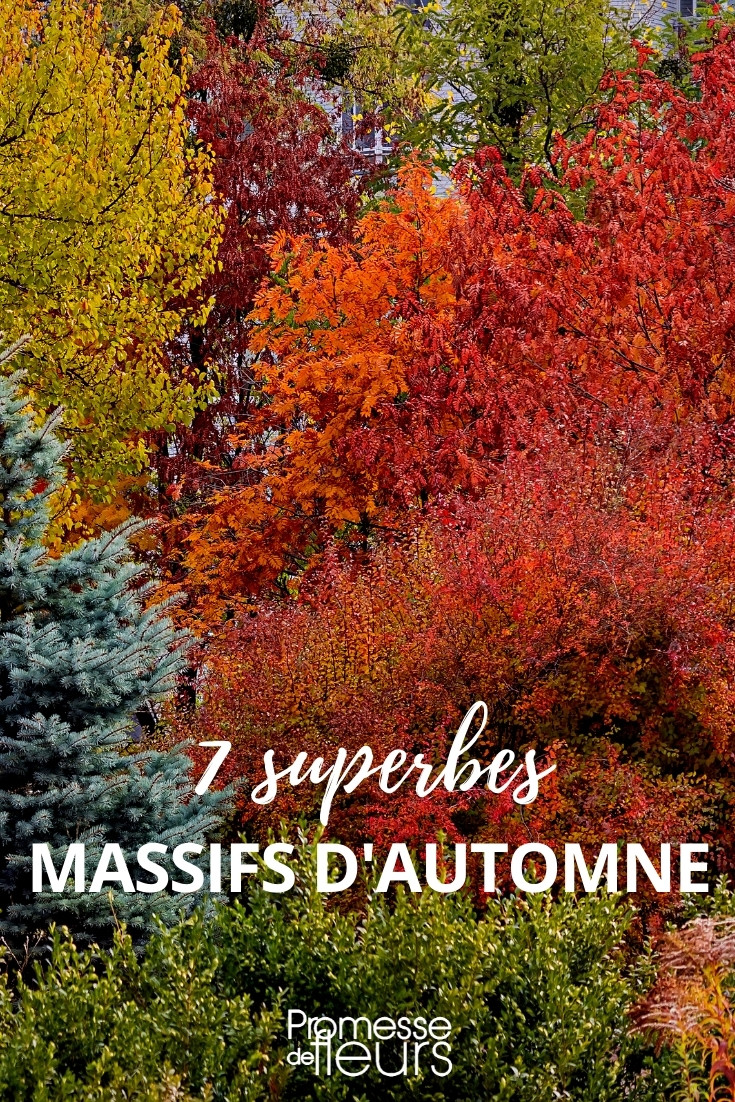































Feedbacks